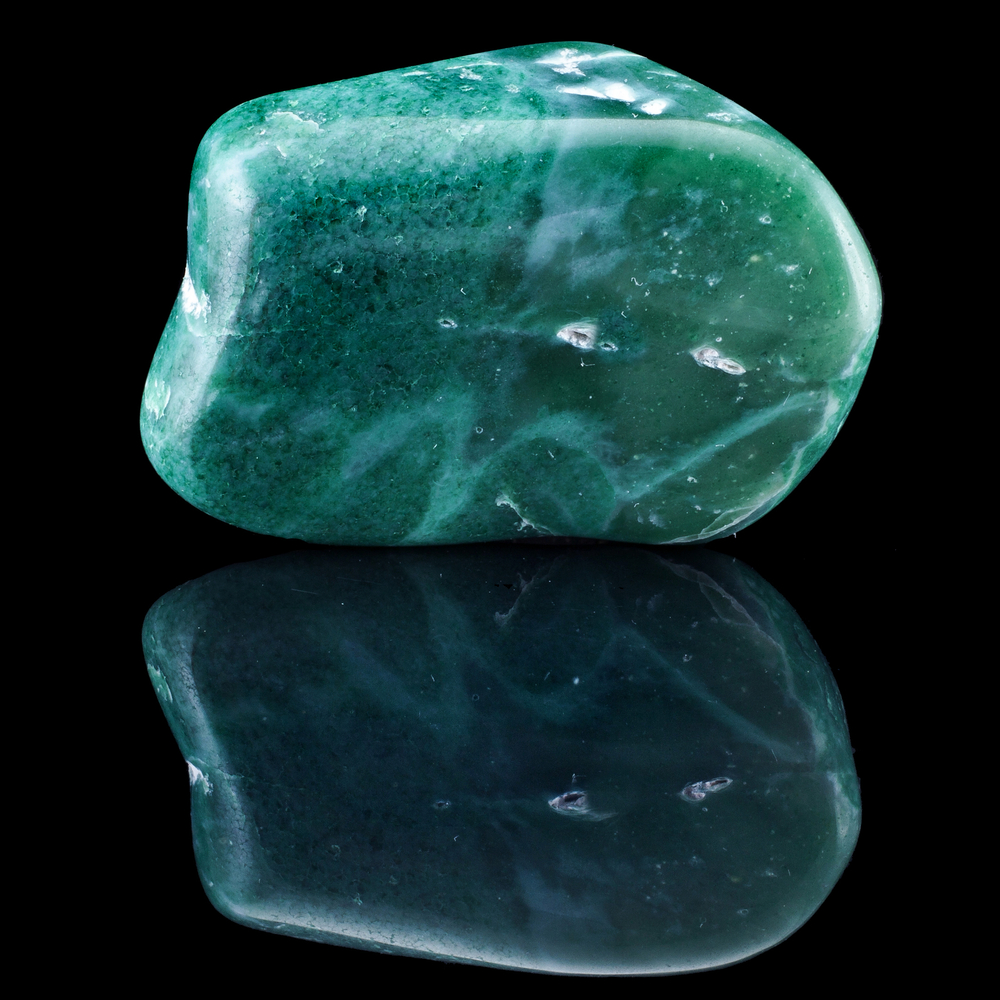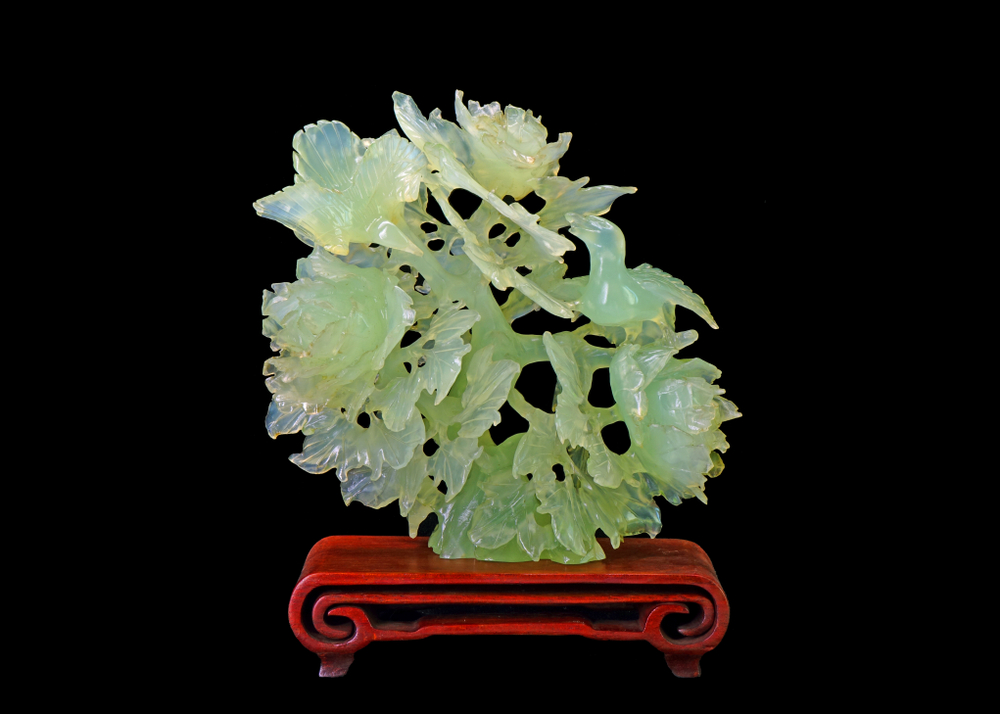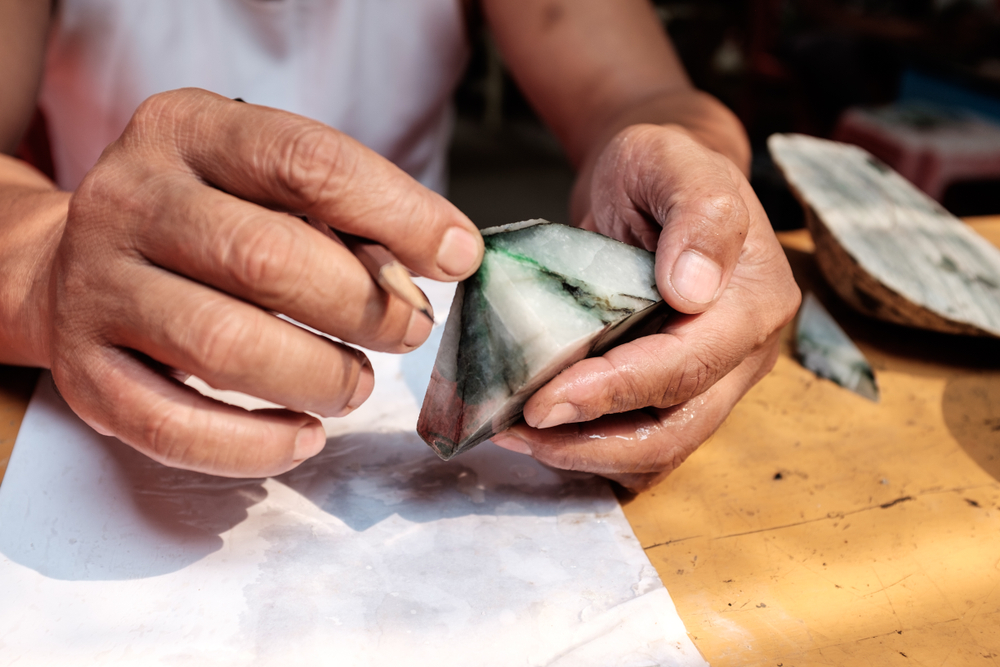Jade is a beautiful stone, which comes in a wide variety of lovely shades aside from the green it’s normally associated with. It’s also worth quite a bit, depending on the variety, grade, and color of the material. That said, it can be hard to determine just what it is worth without a bit of guidance.
So, let’s step into the verdant world of jade, and we’ll discuss the ins and outs of buying, selling, and roughly appraising this beautiful material.
Related: How To Test Jade Under UV Light
Defining Jade
Jade is actually one of two different minerals, not as closely related as you’d think. When discussing jade, we’ll need to separate the two to be able to discuss prices and uses.
Nephrite Jade
Nephrite jade is the material that is most commonly discussed. It’s found in many places across the world and works well as both a tool material and for use in jewelry. The jade used by the Maori people was of this variety, as was much of the jade used in early Chinese history.
Nephrite jade is comprised of amphibole minerals. Specifically actinolite or tremolite. The bulk of the material is a light green color, but there are white, yellow, brown, grey, and black varieties known. It’s a prized lapidary material, with a good hardness of 6.0-6.5 on the Moh’s scale.
Nephrite generally has a fibrous crystal habitat, making it a tough material. It ranges from opaque to translucent. The Chinese call the translucent white varieties “Mutton Fat” jade, while the Maori refer to it as pounamu. The latter word can also refer to other green, hard stones found in New Zealand, so it’s not quite an exact definition.
While nephrite jade is widely spread, the bulk of modern lapidary material comes from Western Canada, although it can be found down the entire Pacific Coast of North America. It’s also found in China, New Zealand, parts of Europe, and across Southeast Asia.

Jadeite Jade
Jadeite is generally considered the more desirable of the two stones, and it’s generally much more expensive. Jadeite is a gem-grade pyroxene and is much rarer than nephrite. The majority of this material comes from Myanmar, with lesser quantities found in California, Guatemala, and Japan. Places outside of Myanmar may house jade, but it’s rarely of gemstone or even lapidary grade.
Jadeite is harder than nephrite jade, sitting between 6.5 and 7.0 on the Moh’s scale. Like nephrite, this tough material has been carved, worked, and used as a tool for much of human history in the areas where it was found.
Jadeite is generally green in color, from a bright apple green to a much deeper emerald green. It’s also found as blue-green, black, purple, and blue stone. These latter colors, particularly purple and blue dominant hues, are much rarer than the green varieties.
Jadeite forms in a massive form. While it can potentially form prismatic crystals, these are very rare and only found in small amounts in vugs in massive jade. The interlocking crystals have a grainier texture than the more fibrous nephrite, and all jadeite is translucent or transparent to some degree.
Telling the Two Apart
There are two very easy ways to determine if what you have is jadeite or nephrite.
Hardness testing is one of them. While close to each other in hardness, a properly hardened steel file (6.5 on the Moh’s scale) should be able to scratch any piece of nephrite and won’t affect the majority of jadeite. Just try scratching with the sharp corner of a flat file, if it leaves a streak of metal then you have jadeite. A scratch will indicate nephrite.
Specific gravity testing is more accurate and should be undertaken for those who are serious about the matter. Jadeite is very dense, sitting between 3.24 and 3.43. Nephrite is comparatively less dense, running about 2.95 to 3.1.

How Much is Jade Worth?
As much as someone will pay for it. Indeed, an ancient Chinese proverb states that “Gold has a price, but jade does not.”
That’s not to say that you can’t get a rough estimate for how much the material will cost you.
Jade, of both varieties, can be sold as rough material, slabs, or finished pieces in descending order of price. Carvings will generally fetch the highest price.
The most expensive jade is the so-called “Imperial Green” jadeite variety. Found primarily in Burma, this material is generally worth $100 a carat at the bottom end of things as a finished piece when it’s untreated. Provenance from Burma adds to the value of this particular shade of green but is less important when discussing other hues.
However, different treatments are commonly used on jade so you need to know the different grades of the material to know if you’re getting a good price or not.
Specifically:
- Type A- No treatment except for possibly a wax coating. This is the most expensive variety of jade by a long shot and you shouldn’t bother buying it unless the material is certified by an independent lab before you buy it.
- Type B- Generally treated with a polymer and bleaching process. This evens out the color tone and allows softer material to be worked like higher grades of jade. This grade is still quite expensive in most cases.
- Type C- Dyed jade is common and relatively affordable. There’s a steep decrease in price between dyed jade material and Type B material.
- Type D- Jade that has been both treated and dyed. This is relatively common and can be quite cheap depending on the material and the form it takes. Most jade sold online is this type, especially as finished products.
The above grades are really only used for jadeite jades, nephrite jade will be discussed below.
As a general rule, green jadeite is the highest priced. True purple or lavender jade can sometimes match it in overall price, or even exceed it, but it largely depends on who it’s being sold to.
Grey and brown jades tend to be worth far less than other colors. Oddly, red jade is also valued far less, sometimes even cheaper than grey and brown. However, sellers seemed to have noticed Western buyers are attracted to the deeper crimson-colored varieties and the price has been rising for some time.
As a general rule expect to spend $100-$3,000 per carat for Imperial Green Jade as a finished product, with the higher end being primarily Burmese jade. For other desirable colors, the price will range from $25-300 per carat. Less desirable jadeite colors will range from $1-$150 per carat.
The reason for this wide range of prices has to do with the material’s properties. The following are the most important:
- Coloration- Deeper colors are generally considered more desirable, and rarity has a lot to do with it as well. While Burmese Imperial Green is the most expensive, other shades will vary in price. In general deeper hues are more expensive.
- Translucency- How translucent the jadeite is will affect the price quite a bit. The more light that’s allowed to pass through the stone, while maintaining a strong saturation of color, the more expensive the stone will be.
- Color Uniformity- Pieces of jade which maintain the same hue without any mottling are worth the most. Uniform colors are important, but a piece with some banding that’s in the same range of hue isn’t going to lose much value.
- Workmanship- Jade is often used for very intricate carvings. The better these are done, the more the piece will be worth. For cabochons and things like solid but uncarved bangles, this is less important unless the work is really shoddy.
Rough material is the cheapest, with slabs being a little bit more expensive. I recommend starting with rough if you’re planning to work the material yourself but make sure you know how to nest cabochons well to save on this expensive material.
Expect to pay upwards of $1/gram for high-quality rough material. You’ll pay 2-3 times that for slabbed material.
Naturally, some shades will go for more or less.
Nephrite Jade
In general, nephrite jades are worth far less than jadeite jades. It’s not the cheapest stone out there, but it’s not going to break the bank for most lapidaries either.
As a general rule of thumb, you’ll end up paying about $100 per pound (~453.6g) for nephrite jade. Some of the more desirable colors can be more, and some of the shoddier materials can be less.
Prices vary wildly for finished pieces, as the stone is generally valued on its own and not necessarily by carat weight like other semiprecious stones. About the highest I’ve seen online runs $0.50 to $2 per carat.
Nephrite’s easy availability makes it a good mid-end material for lapidaries who want to move on from budget jaspers and other very cheap materials and begin moving towards more expensive pieces.
It’s not super cheap, but you won’t feel too badly if you mess up either.
Selecting Good Jade for Lapidary Use

Most jadeite on the market is suitable for lapidary use. As a general rule, the massive form of jade combined with careful mining leads to a material that rarely has the kind of internal fractures you may run into in other lapidary materials.
The best pieces of rough, for both jadeite and nephrite, are solid cobbles with good coloration. These can be slabbed and worked very well and rarely have any problems internally, just be aware the qualities listed above will affect the end price of the product. Good river cobbles of small size can fetch more than $100.
Nephrite that’s sold is usually of good enough quality to be used but it’s more prone to internal fractures. That’s not to say the material itself is prone to them, quite the opposite, but they do happen more frequently than you’ll see with jadeite since it’s not as tough of a material.
One thing I’d make sure of when purchasing rough jadeite is that it has some matrix on the exterior of the piece. While this may cut down a bit on usable material, it’s much harder to fake jadeite with an intact matrix than other forms of the material. Spend some time studying known nodules of jade so that you have a good idea of what it looks like.
Jadeite is generally windowed and pictured with a light shining into it to demonstrate color and translucency. If it lacks a picture or video showing this, you may want to skip the piece.
Places to Buy and Sell Jade Online
For purchasing jade (whether nephrite or jadeite), I strongly recommend using a social media program like Facebook or Instagram to connect with sellers in the country of origin you’re buying from. The material is expensive enough that it will pay off to have these personal connections even if it is a bit more time-consuming than simply logging into a site.
The same goes for selling, try and find lapidaries or carvers who are looking for the material that you have on hand. This is the best way to get a great profit out of jades that are colors other than green.
Carvers, in particular, like to find odd shades of jadeite and nephrite like lilac or blue, since it’s rare to find materials that can hold up well for extremely detailed carvings.
If you’re not willing to put in that much effort, I’d suggest eBay or GemRockAuctions for both buying and selling. Etsy is often hit or miss for stones but it’s got a ton of rough jadeite and nephrite as well.
Detecting Fake Jade
Because of its high value, there is a lot of fake jade out there. It’s one of the biggest reasons that I recommend forming a personal relationship with sellers rather than blindly throwing your money at an unknown entity.
There are a few different kinds of fakes out there, and some can be more difficult to detect than others. This is one of the issues of buying online, but not everyone can take a weekend trip to Myanmar or Siberia to meet with sellers in person.
In general, hardness testing and specific gravity tests will let you know what you have. It’s important to be able to distinguish between nephrite and jadeite due to the large difference in price, but the task ranges from very hard to impossible based on pictures and video alone.
Glass material is among the easiest to detect when looking at pictures. Remember what I said about the light test? Take a closer look at the pictures before committing to the purchase. You may be able to see bubbles where the light shines. This indicates glass.
Glass also has a lower specific gravity than jade, sitting at about 2.54. It may not hurt to start with a small purchase and test it thoroughly before using a seller again. Glass is often used to fake precious stones of all varieties, but it’s relatively easy to detect once you know what to look for.
Some people will pass off other stones as jadeite.
Serpentine is a common one, and the higher grades are worth about the same as nephrite jade. It can be detected with a hardness test, but careful choice of pieces may make it impossible to tell from pictures.
Australian chrysoprase, a chrome chalcedony, is a close mimic for the higher grades of green jade. It has slightly different color zoning and generally has a brown matrix, which can make it distinguishable in rough form, but finished pieces will need to be tested for specific gravity. It’s denser than jadeite, sitting at 3.97-4.0.
In general, I’d make sure to test every single piece of jadeite or nephrite you buy and to only purchase small quantities when dealing with a new seller.
Beware Trade Names
This is where things get stupid. Trade names are the bane of every unwary lapidary.
There are several stones labeled as “jade” that aren’t jade at all. The following are some of the more common:
- Malaysian Jade-A very clear chalcedony or quartz variant that’s expertly dyed.
- Styrian Jade- Also called “new jade.” This is a serpentine variant.
- African Jade- A dark green variety of massive grossular garnet, sometimes dyed.
- Mountain Jade- A dolomite-heavy marble that takes dye very well.
- Australian Jade- Australian chrysoprase, passes the light test.
In general, just make sure you look up any variety of jade that you aren’t 100% sure of before you make a purchase. Many of the above stones are quite beautiful on their own, but don’t let yourself be fooled into paying jade prices.
- Online rock and mineral club for collectors of all levels!
- Find community with like-minded rock and mineral enthusiasts.
- Monthly Giveaways!
- Free Access to Entire Digital Library of Products (annual memberships)


